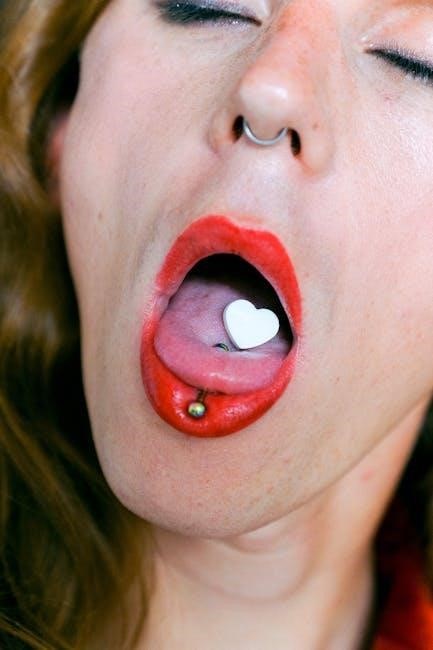Understanding Nose Piercing Sizes
Understanding nose piercing sizes involves gauge, diameter, and length. Common gauges are 18G (1.0mm) and 20G (0.8mm). Hoop diameters range from 8mm to 10mm, while stud lengths typically measure 6mm to 8mm.
1.1. Gauge Sizes for Nose Piercings
Gauge size determines the thickness of the jewelry for nose piercings. The most common gauges are 18G (1.0mm) and 20G (0.8mm). A lower gauge number indicates a thicker piece, which may be more visible, while a higher gauge number means a thinner piece, offering a more delicate appearance. Typically, 18G is preferred for its balance between durability and aesthetics, whereas 20G is ideal for those seeking a subtler look. Thicker gauges are often used during the initial piercing to accommodate swelling, with the option to switch to a thinner gauge post-healing. Personal preference plays a significant role in choosing the gauge size, ensuring comfort and style align with individual tastes.
1.2. Internal Diameter for Hoops
The internal diameter of a nose hoop refers to the distance between the two ends of the ring. Common sizes range from 7mm to 11mm, with 8mm and 9mm being the most popular for a snug fit. The diameter should complement the shape and size of your nose, ensuring the hoop sits comfortably without feeling tight or overly loose. Proper fit prevents irritation and allows the piercing to heal smoothly. Measuring the internal diameter accurately is key, as it directly impacts both comfort and aesthetics. A well-fitted hoop enhances the overall appearance of the piercing, making it essential to choose a size that aligns with your personal style and nasal anatomy.
1.3. Stud Length and Barbells
Stud length is crucial for comfort and proper fit in nose piercings. Standard lengths range from 6mm to 8mm, with 1/4″ (6mm) and 5/16″ (7.94mm) being common. Initially, a longer post is used to accommodate swelling, which is later replaced with a shorter stud. Barbells, used for septum piercings, are measured by the distance between the two ends, excluding beads or charms. The length should match the piercing’s depth to prevent discomfort or migration. Choosing the right stud length ensures the jewelry sits flush against the nose, promoting healing and aesthetics. Always measure carefully or consult a professional to avoid ill-fitting jewelry that could cause irritation or affect the piercing’s appearance.

Types of Nose Piercings and Their Size Requirements

Different nose piercings require specific sizes. Nostril piercings typically use 18G or 20G studs, while high nostril piercings may need slightly larger gauges. Septum piercings often use 16G with 8-10mm diameters.
2.1. Nostril Piercing Sizes
Nostril piercings are the most common type and typically use 18G (1.0mm) or 20G (0.8mm) gauge jewelry. The 20G is ideal for delicate looks, while 18G offers durability. Stud lengths range from 6mm to 8mm, with 1/4″ (6mm) being standard for initial piercings. Hoops for nostril piercings usually have an internal diameter of 8mm to 10mm, depending on the nose shape and desired fit. Proper sizing ensures comfort and prevents irritation during healing. Choosing the right size depends on personal preference, nose anatomy, and the piercer’s recommendation. Always opt for high-quality materials to promote healing and maintain hygiene.
2.2. High Nostril Piercing Sizes
High nostril piercings, placed closer to the tip of the nose, typically use slightly smaller gauges for a balanced look. A 20G (0.8mm) is common for a delicate appearance, while an 18G (1.0mm) offers a bolder style. Stud lengths for high nostril piercings usually range from 5/16″ (8mm) for initial healing to 1/4″ (6mm) post-healing. Hoop sizes are often smaller, with internal diameters of 7mm to 9mm to avoid overwhelming the area. Proper sizing ensures the jewelry sits comfortably without causing irritation. It’s essential to consult a professional piercer to determine the ideal size based on your nose shape and personal preference. High-quality materials are recommended to promote healing and maintain hygiene. This style highlights individuality while complementing facial features.
2.3. Septum Piercing Sizes
Septum piercings typically use thicker gauges due to the cartilage’s thickness. The standard gauge for septum piercings is 16G (1.2mm), though 14G (1.6mm) is also common for those with thicker septums. The internal diameter of septum rings usually ranges from 8mm to 10mm, depending on the individual’s anatomy. For initial piercings, a slightly larger diameter may be used to accommodate swelling, with the option to downsize once healed. The jewelry should fit snugly to prevent irritation but not be overly tight. Septum piercings offer versatility, allowing for various styles like clickers or hoops. Proper sizing ensures comfort and prevents migration or discomfort. Consulting a professional piercer is essential to determine the ideal size for your septum.
How to Measure Your Nose Piercing
Measure your nose piercing using a ruler or caliper. For studs, measure the barbell length excluding balls. For hoops, measure the internal diameter. Use a sizing chart for accuracy.
3.1. Using a Nose Ring Sizing Chart

A nose ring sizing chart is a practical tool to determine the ideal fit for your piercing. These charts typically include gauge sizes, internal diameters, and stud lengths. Gauge sizes range from 16G to 22G, with 18G and 20G being the most common for nose piercings. For hoops, the internal diameter usually ranges from 7mm to 11mm, while stud lengths typically measure between 6mm and 8mm. To use the chart, compare your existing jewelry or measure your piercing with a ruler or caliper. This ensures a comfortable fit and prevents irritation. Piercers often use these charts to recommend the right size, making it easier to choose jewelry that complements your nose shape and piercing location. Proper sizing is crucial for healing and long-term comfort.
3.2. DIY Measurement Techniques

Measuring your nose piercing size at home can be done with simple tools like a ruler or caliper. For studs, measure the post length by marking the distance between the base of the ball or charm and the end of the barbell. For hoops, place the ruler inside the ring and measure the internal diameter. You can also use a piece of paper to trace the piercing hole and measure the distance from the edge of the nostril to the piercing point. This method helps determine the ideal hoop size. DIY techniques allow you to avoid guesswork and ensure your jewelry fits comfortably. Always clean your tools before measuring to maintain hygiene and prevent irritation.

Choosing the Right Nose Ring Size
Choosing the right nose ring size involves considering gauge, diameter, and personal comfort. Common gauges are 18G (1.0mm) and 20G (0.8mm), with diameters ranging from 8mm to 10mm for a snug, irritation-free fit.

4.1. Factors to Consider for the Perfect Fit
When choosing a nose ring, consider gauge, diameter, and length. Gauge refers to thickness, with 18G (1.0mm) and 20G (0.8mm) being common. Hoop diameter ranges from 7mm to 11mm, while stud lengths typically measure 6mm to 8mm. Personal comfort, nose shape, and piercing placement also matter. Higher gauges (20G or 22G) are ideal for delicate looks, while lower gauges (16G or 18G) offer durability. Measure your piercing using a sizing chart or existing jewelry for accuracy. Consider swelling during healing and opt for slightly longer studs initially. Ultimately, balance style preferences with comfort to ensure a flawless fit.
4.2. Common Mistakes to Avoid
Common mistakes when selecting nose ring sizes include guessing your size without proper measurement and ignoring the importance of gauge, diameter, and length. Choosing a ring that is too tight can cause discomfort and piercing irritation, while a loose ring may lead to constant adjustments. Failing to account for swelling during the healing process is another oversight, as initial studs should be longer to accommodate this. Additionally, neglecting personal nose shape and piercing placement can result in an ill-fitting ring. Prioritizing style over comfort is a frequent error, potentially leading to long-term piercing issues. Always measure accurately and consult a sizing chart to ensure the best fit.
Selecting the right nose ring size ensures comfort, style, and piercing health. Use sizing charts, measure accurately, and consider your nose shape for the perfect fit.
5.1. Final Tips for a Comfortable and Stylish Fit

For a comfortable and stylish fit, choose nose jewelry that complements your nose shape and piercing location. Use a sizing chart to determine your gauge, diameter, and length accurately. Opt for 18G or 20G for most nose piercings, as these are standard and versatile. Hoop diameters between 8mm and 11mm are ideal for a snug fit, while stud lengths of 6mm to 8mm suit most nostrils. Avoid overly tight or loose jewelry to prevent irritation. Consider your personal style—delicate for minimal looks or thicker gauges for bold statements. Measure your existing jewelry or consult a professional if unsure. Proper sizing ensures both comfort and aesthetic appeal, keeping your piercing healthy and stylish.


